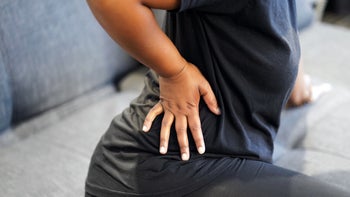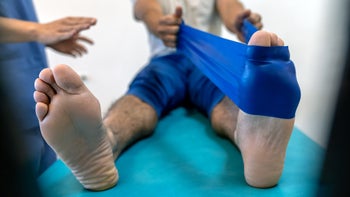
Groin Pain When Walking? 10 Possible Causes, and How to Treat It
Key takeaways:
A muscle strain, overuse, or an injury to the hip are common causes of groin pain when walking.
Most of these musculoskeletal conditions can often be treated (and prevented) with a good stretching and strengthening exercise program.
If your groin pain doesn’t improve with rest, ice, gentle exercise, and NSAIDs, you should see a doctor for evaluation.
Table of contents

The groin is the region where your upper thighs meet your pelvis. If you experience pain in this area while walking, it's important not to ignore it. There could be several causes, such as a strained muscle, a hip joint injury, or another medical condition.
Groin pain can occur suddenly after an injury. It can also be a chronic condition that gets worse over time. And it can affect people of all ages, including older adults and young athletes. In fact, groin pain is responsible for 1 in 10 doctor visits to sports medical centers.
Common causes of groin pain while walking
In addition to feeling groin pain while you’re walking, other symptoms –– such as hip stiffness or a bulge in your groin area –– can help pinpoint the exact cause of your pain.
Search and compare options
Here are the five most common causes of groin pain when walking.
1. Groin strain
A groin strain, also called a pulled groin or adductor strain, is one of the most common causes of groin pain. It happens when the inner thigh muscles are overstretched or torn, often as a result of sudden turning or twisting. It is a common sports injury.
Those with a groin strain will feel pain along their inner thigh and groin, and they may also have bruising, swelling, and reduced strength. Groin strains are classified in three categories, as:
First-degree: Pain without loss of strength or motion
Second-degree: Pain with loss of strength
Third-degree: Muscle tear with loss of strength
Recovery time depends on the degree of your strain. However, strains often take 4 to 8 weeks to heal. So be sure to give your injury time to repair. A physical therapist can help you recover more quickly.
How do you know if you have tendonitis? Recognizing common symptoms –– such as pain that worsens with movement –– can help.
Osteoarthritis often affects the hips. Here's what an avid exerciser wants you to know about living with hip osteoarthritis. (Hint: Listen to your body, and seek medical care when you first notice symptoms.)
Hernias are most common in the groin or abdomen. Learn about the 6 different types of hernias, and how to treat them.
2. Osteoarthritis
Hip joint osteoarthritis can also cause groin pain, and it’s common. It’s difficult to determine exactly how common, but one study suggested that as many as 1 in 4 people may develop hip arthritis before the age of 85.
Osteoarthritis is considered “wear and tear” arthritis, as it often occurs in those 50 years and older. The smooth cartilage in the hip joint wears away over time, leaving behind a rough surface. In addition to pain while walking, those with osteoarthritis may have stiffness, reduced range of motion, and locking or sticking of the joint. The stiffness and pain may result in a limp while walking.
There’s no cure for osteoarthritis. Conservative measures such as exercise and medication can help, but you may need a hip replacement if symptoms progress.
3. Tendonitis
Tendonitis is an overuse injury, which occurs with repetitive movements such as kicking, running, exercising, or doing certain jobs. Groin pain caused by overuse often affects the adductor muscles (this is called adductor tendinopathy) or the hip flexor muscles. You may feel a dull ache in your groin that worsens with walking, running, or other activities and improves with rest. You may have a tender spot that you can pinpoint, as well.
Adductor tendon problems usually get better with stretching and strengthening exercises and activity modification.
4. Hip impingement
Hip impingement, or femoroacetabular impingement, could also be to blame for groin pain during or after walking. Other symptoms include:
Groin pain after prolonged sitting
Clicking or popping at the front of the hip
Limited range of motion with forward bending at the hip
Pain in the outer hip, thigh, and buttocks
This condition occurs when the round femoral head or the hip socket don’t develop properly. Activity modification, hip stretching and strengthening exercises, and surgery are all treatment options.
5. Hip labral tear
Your labrum is cartilage that lines the socket of your hip joint to help with stability. A hip labral tear generally has the same symptoms as hip impingement. These include groin pain with walking, a clicking sound, and stiffness. You may also feel a catching sensation with certain movements.
A labral tear can occur suddenly during an activity or sport that involves forceful leg movements, such as football or soccer. It can also happen gradually over time, especially in those with hip impingement. Some labral tears get better with rehab, but many require surgery.
What else might be causing groin discomfort?
There are less common causes of groin pain when walking. If your symptoms aren’t explained by more common causes, consider the following five possible explanations.
6. Hernia
If you have groin pain while walking, along with a noticeable groin bulge, you could have a hernia. You may also feel heaviness or discomfort in your groin and notice that your symptoms worsen with standing, lifting, or coughing.
Hernias occur when contents of the abdomen bulge out at a weak point in the abdominal wall. Males are more likely to get an inguinal hernia, whereas women are more likely to get a femoral hernia. Both are in the groin area and are likely to need surgery.
7. Osteitis pubis
Osteitis pubis is a chronic condition that results in inflammation in the pubic symphysis joint between your pubic bones. It causes pain in the groin and lower abdomen. And it’s common in athletes who kick, such as soccer players. For these reasons, it can be difficult to differentiate from athletic pubalgia and adductor strain.
8. Strained round ligament
Groin pain during pregnancy could be caused by a strained round ligament. The round ligament is connective tissue on each side of the uterus. This pain often starts during the second trimester, when the pressure of the uterus stretches the round ligament. This can cause pain or a pulling feeling in the groin and pelvis when you walk.
9. Stress fractures
A stress fracture in the hip or pubic bone is often seen in long-distance or marathon runners. A small crack or stress fracture can develop below the femoral head due to overload. Usually it causes groin pain with running, which feels better with rest. There may also be a reduced range of motion and tenderness to touch on the hip. Over time, it can be uncomfortable putting weight on the affected leg.
10. Athletic pubalgia
A sports hernia (also called athletic pubalgia in the medical world) is a common cause of groin pain in athletes. This injury often occurs during sports that require twisting or making quick direction changes, such as hockey or soccer. It is not actually a hernia; there is no bulging, as happens with an inguinal hernia. It is caused by torn tendons that are attached to the pelvis, especially those of the abdominal muscles. The adductor tendons are also often affected with this condition. Symptoms include pain with activity, lower pelvic pain, and tenderness at or near the pubic bone.
How to treat groin pain
Treatments vary depending on the cause of your groin pain. If you are having mild groin pain with walking, there are several home remedies you can try for relief.
Reduce activity: Rest your hip for a few days to allow it to heal. Avoid doing any sports activities, repetitive movements, or exercises that make your pain worse. You don’t want to stop moving completely, as movement increases blood flow to your muscles and joints and helps promote healing.
Exercise as tolerated: Resume activity as tolerated, starting with walking. Progress to hip and core strengthening exercises, including adductor strengthening. Hip stretches will help you maintain mobility and range of motion.
Warm up: Before sports or exercise, doing a 10- to 20-minute warmup consisting of dynamic stretches will help prevent groin injuries.
Apply ice: Apply an ice pack several times a day to help reduce pain and swelling. Don’t apply it directly to the skin, and only keep it on for 20 minutes or less.
Use compression: Wear compression shorts or spandex shorts to prevent swelling and help with pain relief.
Take NSAIDs: Taking over-the-counter nonsteroidal anti-inflammatory drugs (NSAIDs), such as ibuprofen and naproxen, can help relieve pain and swelling.
When should you see a doctor?
If you have new pain that doesn’t go away after a few days, it is a good idea to see a doctor. Here are some specific signs that you should get help for your groin pain:
Pain, stiffness, or swelling that gets worse over time
Recurrent episodes of groin pain
Bulge in your groin or scrotum
Inability to put weight on your leg
Tingling, numbness, or shooting pain down your leg
Change in leg temperature or color
Pain with urination
The bottom line
A muscle strain, overuse, or hip joint injuries can cause groin pain when walking. It is important to rest your hip for a few days, and gradually return to activity. Conservative measures take care of most groin pain, but look out for ongoing symptoms.
Warming up before activity, stretching, and doing strengthening exercises for your hips and core can help prevent some groin injuries. If your pain gets worse, or you have other concerning symptoms, you should see your doctor for further evaluation.
Why trust our experts?



References
American Pregnancy Association. (n.d.). Round ligament pain during pregnancy.
Avrahami, D., et al. (2012). Femoral neck stress fracture in a female athlete: A case report. Journal of Chiropractic Medicine.
Bisciotti, G. N., et al. (2021). The conservative treatment of longstanding adductor-related groin pain syndrome: A critical and systematic review. Biology of Sport.
Dirkx, M., et al. (2022). Osteitis pubis. StatPearls.
Ellsworth, A. A., et al. (2014). Athletic pubalgia and associated rehabilitation. International Journal of Sports Physical Therapy.
Hospital for Special Surgery. (2023). Hip impingement.
Kim, C., et al. (2015). Association of hip pain with radiographic evidence of hip osteoarthritis: Diagnostic test study. The BMJ.
Kiel, J., et al. (2023). Adductor strain. StatPearls.
Maldonado, D. R., et al. (2020). Arthroscopic acetabular labral reconstruction: A review. Journal of Hip Preservation Surgery.
Murphy, L. B., et al. (2010). One in four people may develop symptomatic hip osteoarthritis in his or her lifetime. Osteoarthritis and Cartilage.
National Institute of Diabetes and Digestive and Kidney Diseases. (2019). Inguinal hernia.
Núñez, J. F., et al. (2020). Strength conditioning program to prevent adductor muscle strains in football: Does it really help professional football players? International Journal of Environmental Research and Public Health.
Saurez, J. C., et al. (2013). Comprehensive approach to the evaluation of groin pain. The Journal of the American Academy of Orthopaedic Surgeons.
Su, T., et al. (2019). Diagnosis and treatment of labral tear. Chinese Medical Journal.
Tyler, T. F., et al. (2010). Groin injuries in sports medicine. Sports Health.
U.K. National Health Service. (2022). Femoral hernia repair.
Witstein, J. R., et al. (2022). Sports hernia (athletic pubalgia). American Academy of Orthopaedic Surgeons.

























